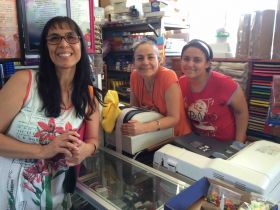Observations About Baja Mexicans and Baja Mexican Food
.jpg) One of the objectives of our trip is to experience firsthand what it would be like to live in different environments abroad, irrespective of what we thought we knew beforehand. We dubbed it the “Try Everything So You Really Know What You’re Talking About and What You Like Tour”, or for short, “You Don’t Know Until You Go”. Part of that experience was to get a feel for the locals. Herewith, our view of Mexicans and Mexican food.
One of the objectives of our trip is to experience firsthand what it would be like to live in different environments abroad, irrespective of what we thought we knew beforehand. We dubbed it the “Try Everything So You Really Know What You’re Talking About and What You Like Tour”, or for short, “You Don’t Know Until You Go”. Part of that experience was to get a feel for the locals. Herewith, our view of Mexicans and Mexican food. The Mexicans in Baja are Nicer Than Typical Americans in the US
Virtually everyone you pass will say “hola”, or “Buenos dias / Buenos tardes / Buenos noches”, and it doesn’t seem to be perfunctory or insincere. Perhaps I’m just naïve, but I don’t think so. It doesn’t look like they’re smiling just to try to sell me something. Why? Because in fact the vast majority wasn’t trying to sell me anything; they were just walking by.
Here are some other incidents I remember just in six weeks that cause me to come to this conclusion:
- We were walking on the beach in Tecolote (Tecolote video), just southeast of La Paz, and came across three young men and a young woman who were just setting up. It was probably obvious to them we were Gringos. In halting English, after saying hello, one of the men offered us a beer. (That's their picture at the top of this story.) When we demurred, he tried again. Finally, a bit exasperated, he brought out his trump card: “But it’s Tecate!”
- Something similar happened when I was visiting Bahia de Suenos (Bahia de Suenos video here), a gorgeous beach with an upscale, American-priced restaurant called Gran Sueños about half an hour away from the little village where we were staying. The beach has public access. I ran into a young family in which the husband / father told me he worked in construction, so, by US standards, he couldn’t be making a lot of money. Just a few moments into the conversation, they offered me a beer out of their ice chest. When I thanked them but refused, they offered a soda. About half an hour later I saw this husband / father at the bar at what for him would be a pricey restaurant. He had ordered beer (at US prices) to replace what they had drank, which is all the more remarkable when I considered how much money in his terms that beer he had offered me had cost him.
- We had driven to the parking lot of Baja Ferries to ask questions about taking our dogs. Two men in the car next to us had evidently seen our Arizona license plate (or us) and as soon as we got out of the car, one of them asked us in not perfect English if we needed any help. Was he employed by the ferry company? No. Was he in the hospitality industry or trying to sell us something? No. He was just an ordinary Mexican trying to help out some evidently bewildered-looking Gringos.
- I went to ask the veterinarian in our very small town, Christian Pozo if he knew a place I could rent some kennels for our dogs because the ferry requires them. He said he didn’t know any place to rent them, but they would probably be cheapest to buy at a members’ only big box store at which he was a member. When I told him I wasn’t a member, he told me he would buy them for us the next time he was there and we could just reimburse him for them. Would your vet do that for you? Later, when he discovered that I wasn’t clear on certain procedures on the ferry because I didn’t speak Spanish very well, he told me not to worry. He would call the ferry company the next day and ask them on our behalf. All I had to do was to come back and he would answer my questions, of course, at no charge. (YouTube of interview with Dr Pozo here.)
-
 When we were getting our visa paperwork, we had to find a store with Internet access, which we did. The clerk (who spoke close to zero English) spent on and off an hour or so to help us understand the forms. (Did you know that if you’re from the US, your nationality is “Estadounidense”? I certainly didn’t.) When we tried to give her 50 pesos (less than US $3) for her trouble, she refused. It took us several additional minutes to talk her into it. (That's a picture of her by the cash register.)
When we were getting our visa paperwork, we had to find a store with Internet access, which we did. The clerk (who spoke close to zero English) spent on and off an hour or so to help us understand the forms. (Did you know that if you’re from the US, your nationality is “Estadounidense”? I certainly didn’t.) When we tried to give her 50 pesos (less than US $3) for her trouble, she refused. It took us several additional minutes to talk her into it. (That's a picture of her by the cash register.)
- If you don’t speak good Spanish, but you’re polite and try, if your experiences are like ours, the Mexicans will be incredibly happy to help you. Almost all of them will also tell you that they understand and appreciate your difficulty, and try to commiserate with you by saying that it is hard for them, too, as they are trying to learn English. When I point out that I’m in Mexico, so it is my obligation to learn their language rather than theirs to learn mine, they usually get embarrassed and don’t respond.
Stereotypes About Mexicans
In the six-plus weeks we were in Baja, here are my impressions about the stereotypes of the typical Mexican:
-
 Mexicans are lazy. I saw Mexicans working in construction 10 hours a day, six days a week, and then, help their family build onto their home on Sunday. Several I met had more than one job. I had described the car wash owner / restaurant manager / co-owner of a pastry shop earlier (here’s the YouTube video of our interview), but Orlando, the man who took the prize for the most jobs (at six), was the one who showed up at 9 PM with his water truck to fill our pila (large container of water). You can see the sign with his six businesses in the nearby picture. Did I see Mexicans sometimes take a rest during the day by doing as little as possible? Yes. And you would, too, if you were working in 90+ degree weather with high humidity for 10 hours.
Mexicans are lazy. I saw Mexicans working in construction 10 hours a day, six days a week, and then, help their family build onto their home on Sunday. Several I met had more than one job. I had described the car wash owner / restaurant manager / co-owner of a pastry shop earlier (here’s the YouTube video of our interview), but Orlando, the man who took the prize for the most jobs (at six), was the one who showed up at 9 PM with his water truck to fill our pila (large container of water). You can see the sign with his six businesses in the nearby picture. Did I see Mexicans sometimes take a rest during the day by doing as little as possible? Yes. And you would, too, if you were working in 90+ degree weather with high humidity for 10 hours.
- Mexicans are bad drivers. This one requires some nuance. In Baja, there are two types of drivers: 1) skilled; and, 2) severely injured or dead. They are generally good drivers who, in my opinion, take too many chances. And a full stop would be nice sometimes. (Tips on driving in Mexico here.)
-
 Mexicans are dishonest. More than once, I was asked by a waiter if I had intended on leaving as large a tip as I did. Others refused money. A man collecting trash on a beach I was visiting walked the 100 yards to my location just to ask me if the shoes he had found earlier that day belonged to me. His picture is nearby.
Mexicans are dishonest. More than once, I was asked by a waiter if I had intended on leaving as large a tip as I did. Others refused money. A man collecting trash on a beach I was visiting walked the 100 yards to my location just to ask me if the shoes he had found earlier that day belonged to me. His picture is nearby.
Mexican Food
Mexicans really know how to cook. And bake. In the entire time we were in Baja and on the ferry, the only average meal we’ve had has been on the ferry, and for a ferry, it was pretty good. The restaurants are fantastic, and, if you stay away from Gringo places, you’ll pay almost embarrassingly low prices for great food. Also, the portions are even slightly bigger than American portions. The second best hamburger I ever had in my life was at Las Palmas, in La Ventana, for 70 pesos (about $3.75). To her surprise and delight, my wife kept ordering fish she never would even have asked about in the States because it would have been “market price”; i.e., too expensive. 140 pesos (a little over $7) for yellowtail. 160 pesos (a little over $8) for sea bass.
Perhaps one of the reasons why the food is so good in Mexico is that it is so fresh and everything, it seems, is made to order. Even the tortillas are great, once again, almost certainly because they are so fresh. We became fans of a local tortilleria in La Ventana, where they showed us the production process and even let Jet try making some. (YouTube here.)
The prices in the restaurants are generally much lower in the non-Gringo places in Baja .jpg) California than in the US and the prices at the supermarkets are just a little lower, so it’s almost cheaper to just eat at restaurants than to buy your food and cook it yourself. One of the exceptions to this was one day, where at two different supermarkets, I saw a several elaborate and decadent cakes that looked to be maybe 10 inches to a foot in diameter, and about 5 inches tall for 50 pesos each (about $2.75). (Video of shopping and the cakes here.) Unfortunately, we could only eat one at a time. These were on sale, so the usual price was about double that, at just about $5.50. In addition to these silly prices for cakes, the pastries are great, and the cost is about 40% less than in the US. Don’t go to Mexico and expect to lose weight.
California than in the US and the prices at the supermarkets are just a little lower, so it’s almost cheaper to just eat at restaurants than to buy your food and cook it yourself. One of the exceptions to this was one day, where at two different supermarkets, I saw a several elaborate and decadent cakes that looked to be maybe 10 inches to a foot in diameter, and about 5 inches tall for 50 pesos each (about $2.75). (Video of shopping and the cakes here.) Unfortunately, we could only eat one at a time. These were on sale, so the usual price was about double that, at just about $5.50. In addition to these silly prices for cakes, the pastries are great, and the cost is about 40% less than in the US. Don’t go to Mexico and expect to lose weight.
.jpg) California than in the US and the prices at the supermarkets are just a little lower, so it’s almost cheaper to just eat at restaurants than to buy your food and cook it yourself. One of the exceptions to this was one day, where at two different supermarkets, I saw a several elaborate and decadent cakes that looked to be maybe 10 inches to a foot in diameter, and about 5 inches tall for 50 pesos each (about $2.75). (Video of shopping and the cakes here.) Unfortunately, we could only eat one at a time. These were on sale, so the usual price was about double that, at just about $5.50. In addition to these silly prices for cakes, the pastries are great, and the cost is about 40% less than in the US. Don’t go to Mexico and expect to lose weight.
California than in the US and the prices at the supermarkets are just a little lower, so it’s almost cheaper to just eat at restaurants than to buy your food and cook it yourself. One of the exceptions to this was one day, where at two different supermarkets, I saw a several elaborate and decadent cakes that looked to be maybe 10 inches to a foot in diameter, and about 5 inches tall for 50 pesos each (about $2.75). (Video of shopping and the cakes here.) Unfortunately, we could only eat one at a time. These were on sale, so the usual price was about double that, at just about $5.50. In addition to these silly prices for cakes, the pastries are great, and the cost is about 40% less than in the US. Don’t go to Mexico and expect to lose weight. We have three words to describe the pastries we’ve had in Mexico:
1. Phenomenal
2. Cheap
3. I can’t wait to eat another one
Next, I’ll describe some “must know” tips about traveling and / or living in Baja California.
See links to all Mexico road trip stories below. You are currently reading the one highlighted with the yellow background.
To see hundreds of questions answered by expats already living in Mexico, click here.
To see hundreds of questions answered by expats already living in Mexico, Panama, Belize, Nicaragua and Portugal, go here and navigate to the place you're most interested in.
Sign up for the Best Places in the World to Retire newsletter. To see additional additional pictures and videos not in the stories, follow us on Facebook. To see more videos of the trip, see our YouTube channel.
Want online, interactive help finding the best place abroad for you? Try the Location Advisor.
To download free research studies conducted with over 1,000 expats currently living in Mexico, click here.
Download the free eBook of all the stories below, "Our Year on the Road & Living in Mexico-- Adventures, Challenges, Triumphs, Lessons Learned"
Links to Mexico Road Trip stories:
Editor’s note: you may freely reprint the article above, provided you put this at the beginning or end:
Content provided by Best Places in the World to Retire, which provides credible answers to questions about moving abroad, expat stories, and a location advisor to help you find the perfect place for you.
Content provided by Best Places in the World to Retire, which provides credible answers to questions about moving abroad, expat stories, and a location advisor to help you find the perfect place for you.



.png)